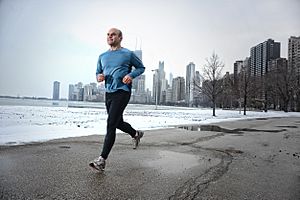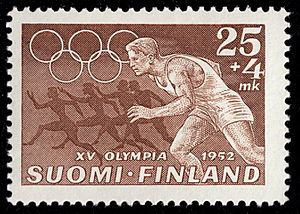Running facts for kids
Running is a way for people and animals to move quickly using their feet. It's a common way to travel on land. Running is different from walking because when you run, both of your feet are off the ground at the same time for a short period. We use different words for running based on how fast someone is going: jogging means running slowly, while sprinting means running very fast.
Running is a popular type of exercise. It's also one of the oldest sports. This exercise is known to be good for your health. It helps your breathing and heartbeat, and it burns extra calories. Running helps you stay fit and active. It can also help reduce stress. When you run, you get thirsty, so it's important to drink water.
Contents
Why is Running Good for You?
- Staying Fit: Running has many health benefits. It can help you lose weight, fight diseases, and even slow down some effects of aging.
- Feeling Better Mentally: Running is also great for your mental health. It can help with sadness or give you time to think clearly.
- Fun and Easy: Running is fun, and you don't need special equipment to do it. When you run, your muscles, lungs, brain, heart, and other organs all get stronger and work better.
- Cross-Training: Running is often used to train for other sports, especially those that need a lot of stamina.
How to Avoid Running Injuries
Running injuries are quite common for people who run often. Many injuries can be prevented by training correctly, wearing the right gear, and being aware of your surroundings.
Physical Tips for Runners
- Warm-up and Cool-down: Before a long run, always do a five-minute warm-up and some stretching exercises. After your run, spend ten minutes cooling down with more stretches.
- Choose Your Surface: For short runs, try to run on a flat surface. For longer runs, coaches often suggest running cross-country, which means running over natural terrain.
- Running Shoes: Some people believe that running in "minimal" shoes (shoes with less cushioning) helps your feet feel the ground better and prevents injuries. However, this is a debated topic. Many coaches and scientists argue that cushioned shoes are better and can prevent injuries to your shins and knees. Many runners with injuries have found that switching to cushioned shoes has helped them heal.
Environmental Tips for Runners
- Hot Weather Running: If it's hot outside, it's best to run in the morning. This helps you avoid getting too tired or overheated.
- Air Quality: Do not run when pollution levels are high.
- Sun Protection: If possible, run in the shade. Wear sunglasses, put on sunscreen, and try to avoid direct sunlight.
- Dress in Layers: Wearing too much clothing can make you sweat a lot, which can cause your body to lose heat too quickly. It's better to dress in layers so you can remove clothing if you get too warm. Always wear the correct footwear.
- Cold Weather Running: When running in cold weather, wear a hat, gloves, and clothing that covers your neck to stay warm.
Running Races and Competitions
Running is a big part of many competitive racing events. Most running races test how fast you are, how much stamina you have, or both. Track and field races are usually split into sprints (short, fast races), middle-distance races, and long-distance races. Races that happen off a track are sometimes called cross-country races. A marathon is a very long race, covering about 42 kilometres (about 26 miles).
Footraces have probably been around for most of human history. They were a very important part of the ancient Olympic Games.
Images for kids
-
Marathon runners at Carlsbad Marathon, USA, 2013
See also
 In Spanish: Carrera a pie para niños
In Spanish: Carrera a pie para niños









